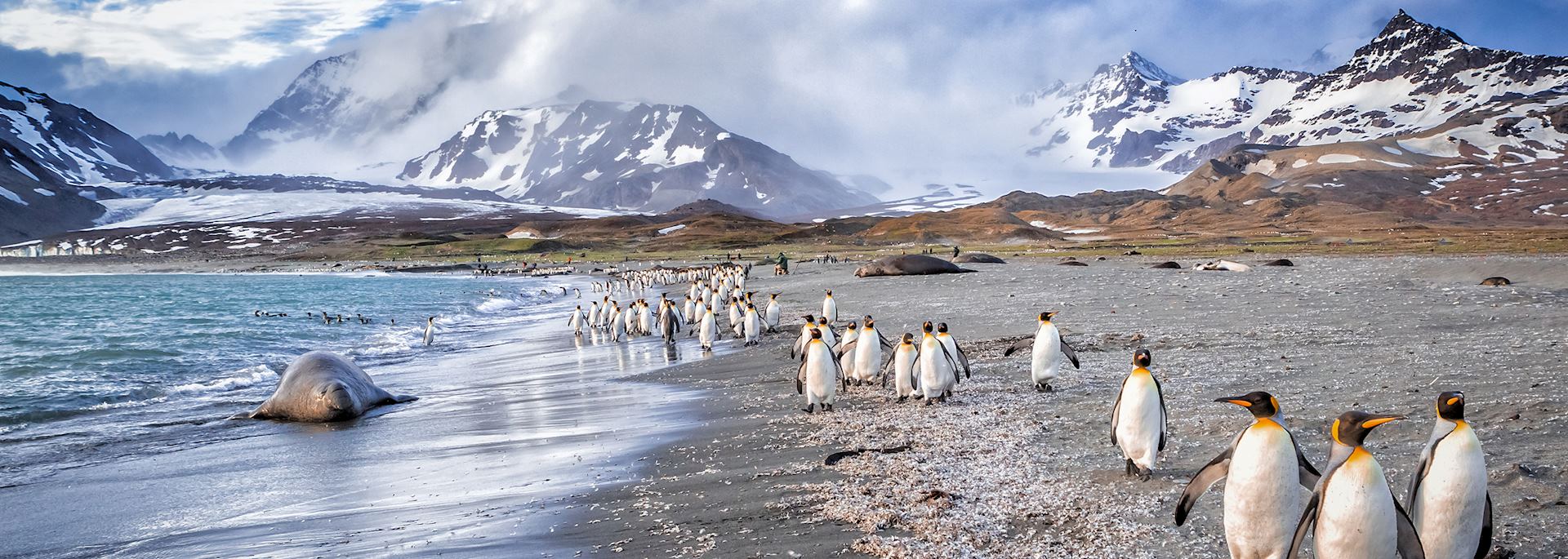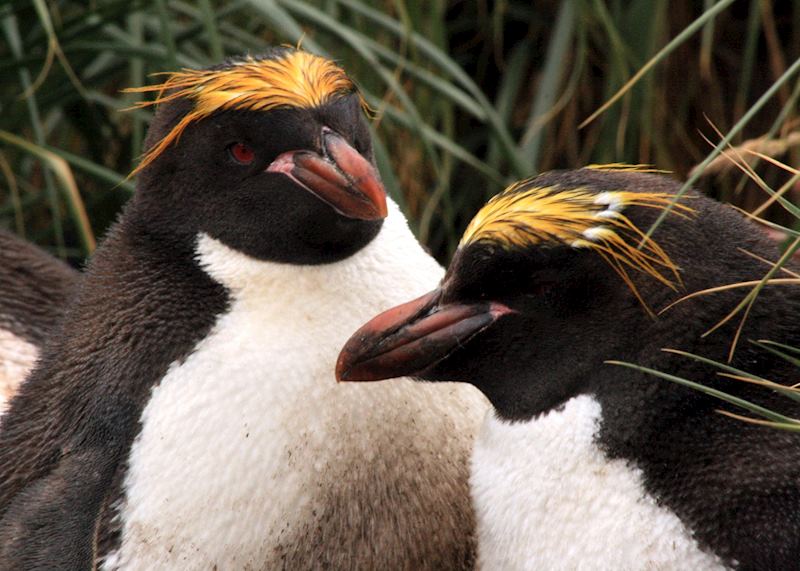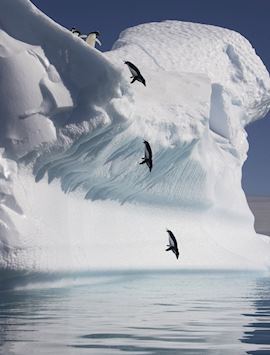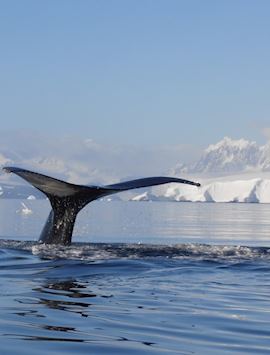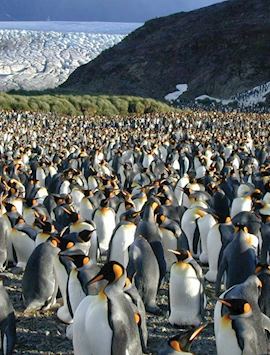By Audley specialist Chloe
It’s the highest, driest, and windiest continent, owned by no one and visited by relatively few — but no one can deny that part of Antarctica’s ineffable, otherworldly allure is its wildlife. Some of which exists nowhere else on Earth.
When planning your Antarctic expedition cruise, I’d encourage you to think hard about which particular species of Antarctic wildlife you’re most eager to see. Penguins are a constant, but what exactly you’ll see can depend on when you go. Certain months are better for both whales and seals, so it’s important to consider when the best time to visit the continent is for you during its short travel window.
Penguins

The poster child of Antarctic wildlife, and with good reason: penguins are present no matter what time you visit the continent, so you’re as good as guaranteed to see them (which can rarely be said of wildlife sightings). There are four species to spot on the Antarctic Peninsula, and they’re fairly distinct.
Adélie penguins are in some ways the most classic-looking, with particularly beady eyes and sleek black-and-white plumage.
Chinstrap penguins sport, as the name suggests, a black band running underneath their beaks, and they have particularly dainty pink feet.
Gentoo penguins are bigger in size, with (like Adélies) a bright orange bill; they also have large shocking-orange flippers for feet.
Macaroni penguins are rarer to see, but in some ways they’re the most eye-catching with their punky yellow head crests. (In fact, I once saw a macaroni penguin who seemed to think he was a gentoo, having made a home for himself in one of their colonies.)
How to see penguins
You’ll hopefully have the chance to go ashore to walk or sit among a penguin colony, perhaps on a shingle beach or a muddy slope. If you do, prepare for sensory bombardment (and not just from the guano, or penguin excrement, which you’ll have no choice but to get used to — and will probably spend a large amount of time trying to avoid photographing). The air rings with cawing and squawking amid the busy private rituals of a thousand family units, especially during courtship season or when chicks are hatching.
You can also observe penguins along the shoreline or on icebergs or pack ice from a Zodiac (a rigid-hulled dinghy used for off-ship exploration) or kayak.
Things to look out for
I love how some penguins bow to each other when returning to their nests after a long parting. You might see groups marching along ‘penguin highways’, worn paths used to journey to and from the water, or standing in perfect lines, almost as if they’re waiting for a bus.
Watch out for Adélie penguins tobogganing and sliding over the ice on their fronts, the only breed to do so. And, if you have the chance to see penguins swimming, you’ll see how they transform from these waddling, slightly comic figures to agile, speedy hunters.
I’ve even heard of penguins scaling a steep slope, sticking their beaks into the ground like walking poles in order to haul themselves to the top.
When to see penguins
November is nesting season. You’ll see courtship rituals, where males often offer females stones for building their nests, and you might spy birds balancing eggs on their (surprisingly dexterous and flexible) feet.
December to early January is a popular time to visit, as this is when chicks hatch and the colonies are a-buzz with frazzled new parents and their inquisitive offspring. The Antarctic treaty forbids visitors to go within 5 m (16 ft) of wildlife, but Antarctica’s penguins — which have never had any land predators — might approach you if you’re stood still, which is permitted. Young, fuzzy-haired chicks are particularly terrible at keeping their distance. They’re usually far too interested in your camera equipment.
February to March is when penguins head out to sea to feed. The colonies aren’t as vast, but the birds themselves are still very much present. I’ve visited in March and was still able to see all the penguins my heart desired.
Whales

Whales seem to exert their own cult fascination, and their presence in Antarctica draws large numbers of visitors there in the hope of seeing one of these giant mammals. Your chances are good if you visit in March (see below), when you could potentially spot fin, humpback, minke, orca, and blue whales.
How to see whales
Most of your sightings will be from the deck of your ship: whales may come to check out the vessel. It’s difficult to be specific about whale sightings — you never know when or if they’re going to occur — but the crystal-clarity of the water in Antarctica does make it much easier to track the whales’ movements.
Heading out in a kayak might also increase your chances of a close encounter, and it’s possible to see them from a Zodiac, too. I personally had my most astonishing whale sightings from a Zodiac in an area called Charlotte Bay. We were floating in the middle of the bay, surrounded by mountains and icebergs, with pods of humpback and minke whales swimming in circles around our boats for about three hours. You could hear mothers calling to their calves, smell their breath, and even feel the patter of spray from their blowholes.
Things to look out for
Whales behave in all sorts of intriguing ways. You might see them spyhopping (holding their body near-vertical in the water and poking their heads out), diving (sometimes with the bonus of a tail fluke), breaching, or working as a team to trap krill and other potential food within a ring of bubbles, known as bubble net fishing.
When to see whales
Species arrive in the continent in January, but March is the best time for sightings. This is when ice begins to form over Antarctica’s bays — krill start gathering under the ice, so whales accumulate to feed, making them easier for your vessel to track.
Seals

A good few seal species are present in Antarctica. The most traditionally photogenic are perhaps fur, Weddell, and crabeater seals, and you might even glimpse solitary, menacingly powerful leopard seals. Weddell seals are endearingly pudgy, while crabeaters are more sociable and tend to hang out in groups.
You might also see elephant seals — so-called for the males’ fleshy appendage, which is reminiscent of a trunk. They lord it over their harems and pups, and you could see young males play-fighting and scrapping.
How to see seals
You don’t necessarily need a dry landing — kayaking is also an excellent way to get a closer look at species. You might see them lolling lackadaisically on icebergs or beaches. If you do set foot on land near seals, your ship’s expert guides usually recommend you carry a walking pole, which you might have to wave above your head in order to keep particularly assertive seals at a safe distance.
When to see seals
December to January, the Antarctic’s high summer, is when seals are typically at their most active.
Other birdlife

If you’re traversing Drake Passage, the expanse of water between Ushuaia in Argentina and the Antarctic Peninsula, you’ll gaze out for two days at a seemingly endless and uninhabitable ocean. But, it’s actually a chance to see rare birdlife.
Wandering albatrosses, which may have been out at sea for years, sometimes swoop around your ship. You might also see cape petrels, striking birds with an almost piebald-type plumage. I somehow find it comforting that, in this ocean at the end of the world, there are these hardy species. Like me, you might find yourself skulking around the stern, trying to capture that perfect shot of a bird in flight.
Look out, too, for skuas when you’re exploring penguin colonies. They pose a continuous threat, circling to steal eggs, while penguins poke their beaks up in defiance.
Antarctic shags, which are star divers, and Arctic terns, which migrate here all the way from the opposite pole, are also possible to spot while you’re exploring on land in the peninsula.
Extending your trip: wildlife in South Georgia

King penguins are the trump card for South Georgia, a sub-Antarctic island that you can easily incorporate into a wider Antarctic expedition cruise.
These tall, graceful penguins with their trademark yellow-orange blush at their throats, have a rolling breeding cycle, so it’s possible to see chicks here year-round, though early November sees a flurry of courtship rituals. These chicks, I think, are a particular delight: podgy and larger than their parents, ever-curious, and swathed in fuzzy brown down.
My tips for observing Antarctica’s wildlife:
- Spend as much time as possible out on deck, and keep your camera to hand. Bear in mind that in its summer, Antarctica has almost 24 hours of daylight, giving you lots of opportunity to be outside, observing.
- Try kayaking, even if you don’t have a lot of experience: it will usually give you closer views of wildlife while being less obtrusive as there’s no motor noise.
- Attend your vessel’s on-board lectures — there’ll usually be at least one during your cruise that’s given by a naturalist or other expert in Antarctic fauna.
Read more about trips to Antarctica
Start thinking about your experience. These itineraries are simply suggestions for how you could enjoy some of the same experiences as our specialists. They're just for inspiration, because your trip will be created around your particular tastes.
View All Tours in Antarctica
